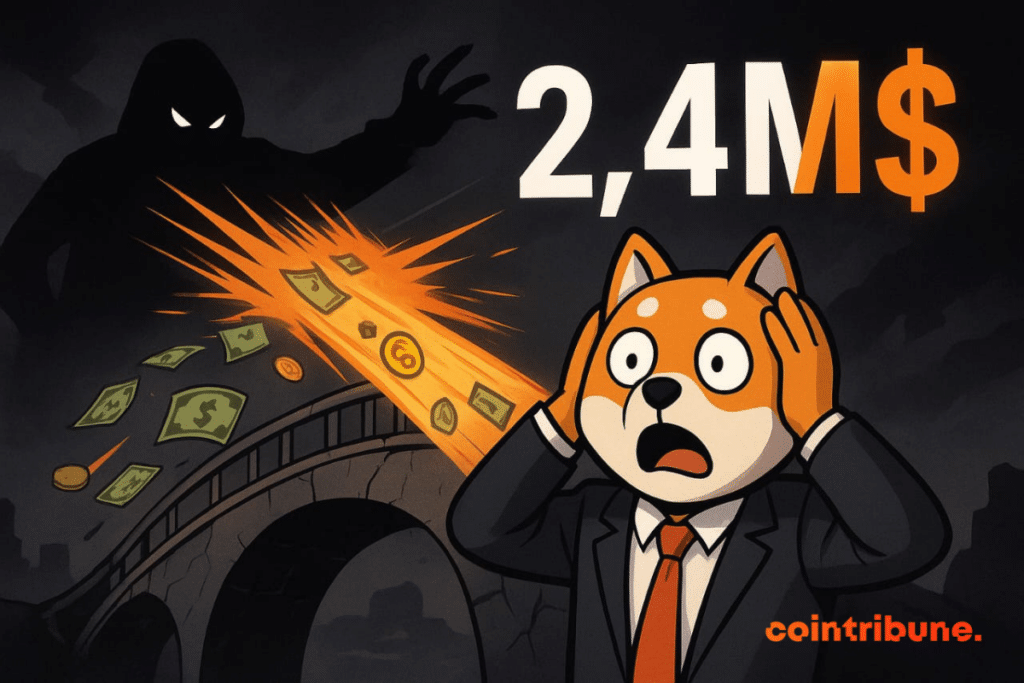Crypto : Shibarium Bridge victim of a 2.4 million $ flash loan attack
The crypto scene has once again proven that no protocol, no matter how popular, is completely safe. The Shibarium bridge, a strategic gateway between the Layer 2 of the same name and Ethereum, was the target of a swift flash loan attack that siphoned the equivalent of 2.4 million dollars. Behind this move, a maneuver both technical and psychological demonstrating the persistent flaws of decentralized security.

In brief
- Shibarium Bridge suffered a 2.4 million dollar flash loan attack, targeting its BONE and SHIB tokens.
- Developers suspended certain functions and requested cybersecurity experts to limit the damage and investigate.
- After a 99% drop in August, this new attack increases the fragility of the Shibarium ecosystem.
A meticulously prepared crypto attack
The operation was no accident. The attacker contracted a flash loan of 4.6 million BONE, Shibarium’s governance token. By exploiting this position, they gained access to 10 of the 12 validation keys, securing a comfortable majority to manipulate the protocol. From there, the script was written: extraction of 224.57 ETH and 92.6 billion SHIB, transferred with surgical precision to their wallet.
But the most surprising aspect is the scale of the plan. The attacker did not limit themselves to the main funds; they also seized KNINE tokens related to K9 Finance for approximately 700,000 dollars. In the crypto ecosystem, such a maneuver could have amplified the chaos, but the swift reaction from the K9 DAO, blacklisting the address, prevented the liquidation of these assets. A rare decision, but vital to contain the damage and indirectly protect Shibarium.
Chain reactions and market impacts
Facing this breach, the Shiba Inu developers acted without delay. Staking and unstaking were suspended, freezing the borrowed BONE and cutting off the attacker from their control lever. The incident, described as “sophisticated” by developer Kaal Dhairya, was reportedly planned over several months. Proof that attackers no longer settle for improvised opportunities but orchestrate true long-term operations.
The direct consequence was a quick onset of volatility. The price of BONE first surged from 0.165 to 0.294 dollar in one hour, then quickly corrected to 0.202 dollar. SHIB, on the other hand, surprisingly rose by 4.5% in 24 hours, a sign that the market has not completely lost confidence. As often in crypto, drama also fuels speculation.
This incident occurs in an already tense context for Shibarium. Last August, the project suffered a near 99% collapse, a brutal drop that shook investors’ confidence. The current attack only rekindles these doubts, confirming that the network’s stability remains fragile despite recovery attempts.
Towards rethought security?
This episode highlights the fragility of cross-chain bridges, true nerve centers of the crypto ecosystem. Despite the involvement of specialized teams like Hexens, Seal 911, and PeckShield to investigate, the question remains: how to sustainably protect protocols that attract both users and predators?
Shibarium developers now consider negotiating with the attacker via a restoration bounty, a pragmatic approach already seen in crypto. At the same time, contact with authorities shows that the boundary between decentralized finance and legal framework is becoming increasingly thin.
One thing is certain: between the 99% drop in August and this multi-million dollar hack, the Shibarium bridge is going through a turbulence zone likely to leave deep marks on the Shiba Inu ecosystem.
Maximize your Cointribune experience with our "Read to Earn" program! For every article you read, earn points and access exclusive rewards. Sign up now and start earning benefits.

Fascinated by Bitcoin since 2017, Evariste has continuously researched the subject. While his initial interest was in trading, he now actively seeks to understand all advances centered on cryptocurrencies. As an editor, he strives to consistently deliver high-quality work that reflects the state of the sector as a whole.
The views, thoughts, and opinions expressed in this article belong solely to the author, and should not be taken as investment advice. Do your own research before taking any investment decisions.